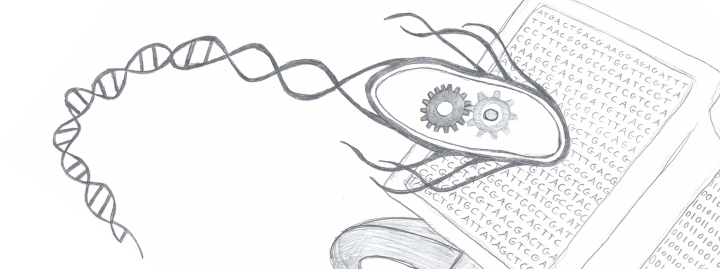CHE.496/2008/Schedule/Systems biology and synthetic biology
From OpenWetWare
Jump to navigationJump to search
Systems biology and synthetic biology
- Discussion leader: George W.
- Systems biology as a foundation for genome-scale synthetic biology link
- This article discusses the connection between systems biology and synthetic biology, specifically how modern advances in systems biology aid the development of the nascent field of synthetic biology
- One current approach taken by systems biologists is to 'reconstruct' a system
- This is done by first incorporating every relevant reaction into a stoichiometric matrix
- From this, a set of parameters can be identified
- By applying 'flux balance analysis' to this model, a concrete model that accurately predicts temporal evolution of the system can be achieved
- Requires many parameters to be defined as well as a 'demand reaction' to drive the system, which is unknown in most cases outside of exponential growth
- Much of the software developed for systems biology will be useful in the pursuit of computational analysis in synthetic biology
- In order to deal with unknown parameters, synthetic biologists can use directed evolution to make a system conform to known parameters; in short, make the system imitate the model
- New experimental techniques are always improving parameter estimation and system reconstruction, and these will clearly benefit both systems and synthetic biologists
- Maybe we can use some of these techniques in our own work?
- Developing our own 'reconstruction' seems unlikely to be feasible, although if we're working with a known system, we may be able to use others' results
- The OptStrain strategy may be feasible if we do metabolic engineering, but I doubt we'll be doing a qualitatively new pathway, so this is likely unnecessary
- Modular approaches to expanding the functions of living matter link
- This article describes many techniques used by modern synthetic biologists to achieve novel function in biological systems
- The first section describes how we can take advantage of machinery already present in the cell to engineer qualitatively different function from anything naturally occurring
- Elowitz' repressilator shows oscillation from mutual repression, a system never observed in nature
- This system is extremely sensitive to noise, so is difficult to accurately model except on a gross population level
- Collins' bistable switch permits epigenetic memory, allowing novel response to various stimuli
- Leibler's work systematized topological consequences of several repressors and promoters
- By analyzing 512 different topologies, many useful logical functions were derived
- V. fischeri's quorum sensing permits tumor infiltration, and the familiar bullseye spatial differentiation can be achieved by separation into two functional halves, signal sending and receiving
- Elowitz' repressilator shows oscillation from mutual repression, a system never observed in nature
- The second section explores various unnatural machinery introduced to the cell
- Voigt et. al. were able to create a bacterial camera by incorporating an engineered photoreceptor
- Goulian et. al. modified chemotaxis receptors in E. coli to respond to a variety of attractors
- Hellinga's dead-end eliminaton algorithm permits creation of proteins that recognize novel substrates, such as TNT and serotonin
- Lim et. al. combined two scaffold proteins to link the input of one to the output of the other, a connection completely absent in the natural system
- Schultz has been able to expand the genetic code, potentially providing radically different protein structures and functions from anything in nature
- Perhaps one of the more interesting ideas present in the article is that of post-transcriptional regulation, as this provides tools independent of genetic manipulation to control and regulate
- Smolke's caffeine sensor uses RNA aptamers to suppress target mRNA from transcription in the presence/absence of a specific ligand (in this case, caffeine)
- Not only does this give extremely rapid suppression of the target mRNA, but it also provides orthogonal suppression of any number of targets, as the aptamers can be finely-tuned for a wide range of inducers/suppressors
- Collins et. al. have been able to repress RBSs with specific sequences directly before them designed to form a hairpin with the RBS; only when RNA that binds the suppressor sequence is present is the RBS free to bind to the ribosome
- Rackham and Chin have created functionally new ribosomes that do not interact with the original genome at all
- These can bind to new RBSs that won't interfere with the original ribosomes
- Orthogonal ribosomes can be used to create logical circuits
- Smolke's caffeine sensor uses RNA aptamers to suppress target mRNA from transcription in the presence/absence of a specific ligand (in this case, caffeine)
- There was no dearth of examples in this article, all of which are important to be aware of, and some of which might be useful in our own project
- Orthogonal function seems paramount in development of large-scale complex systems, since unpredicted interaction between disparate parts will swiftly render them at best impaired, at worst non-functional
- Combinations of pre- and post- transcriptional regulation allow control of the system on multiple timescales
- George Washington 16:29, 2 April 2008 (EDT)
